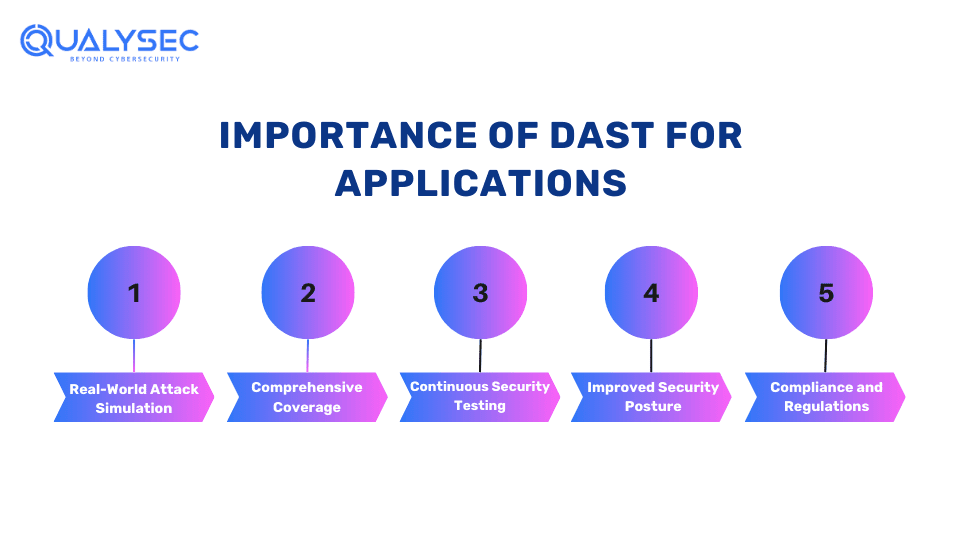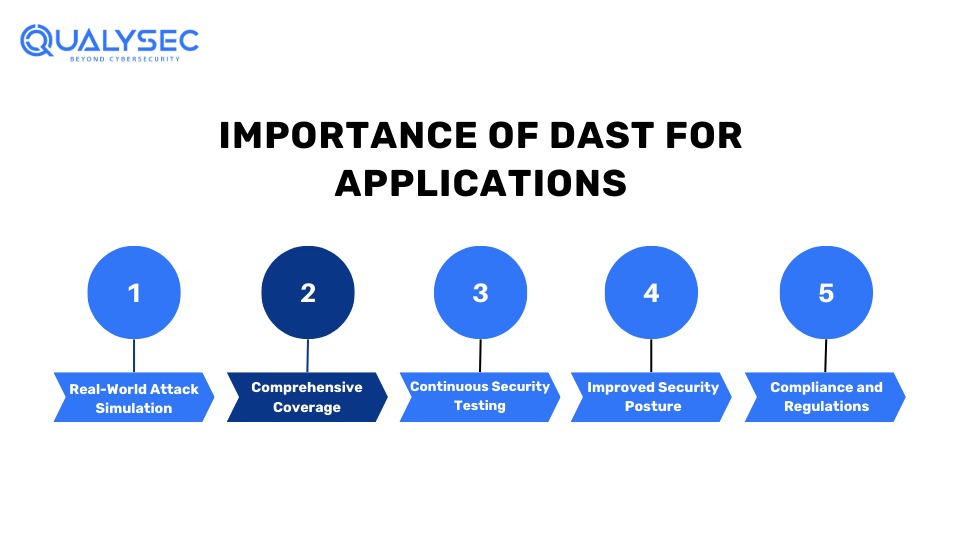As software development evolves, so does the need for robust security measures. With the increasing complexity of cyber-attacks, ensuring the security of applications has become a top priority. Dynamic Application Security Testing (DAST) is a critical approach in securing software applications from evolving cyber threats.
This blog delves into the intricacies of DAST, including its implementation methodologies, types, benefits, and drawbacks, and how it differs from Static Application Security Testing (SAST). Therefore, understanding DAST is crucial for anyone involved in software development or application security.
What Is DAST (Dynamic Application Security Testing)?
Dynamic Application Security Testing (DAST) is a form of black box testing that determines the security of an application while it is actively running. Unlike other testing approaches, DAST operates outside the application and emulates real-life attacks to detect weaknesses. However, this approach is similar to how an attacker would attempt to exploit the application and is, therefore, highly beneficial when identifying runtime vulnerabilities that static methods are likely to overlook.
DAST tools conduct various tests to identify critical vulnerabilities such as SQL injection, cross-site scripting (XSS), and other standard web application weaknesses. The primary goal of DAST is to identify vulnerabilities that attackers can exploit in the production environment, ensuring the application’s solidity and safety.
How Does DAST Work?
An organized methodology is required to implement DAST effectively. Here are the essential steps to follow:
1. Automated Scanning
The scanning step often initiates DAST, in which the tool navigates around the web application to find its structure, pathways, and information about various components and functions, allowing the tool to perform additional analysis.
2. Manual Attack Simulation
In the attack simulation phase, DAST testing acts like an attacker and sends several inputs and payloads to the application. This step looks for exploitable weaknesses such as SQL injection, cross-site scripting (XSS), and other types of attacks.
3. Vulnerability Detection
In vulnerability detection, DAST focuses on the application’s response to the simulated attacks. It detects and records possible security issues, including broken authentication, improperly configured systems, or data leakage that cybercriminals can use.
4. Reporting
DATS testers develop detailed reports highlighting all the vulnerabilities that have been identified. Such reports comprise explanations, the extent of the problem, and measures on how it can be rectified. Developers and security teams gain valuable information to enhance the application’s security based on the results obtained.
Are you seeking a sample DAST report? Download one immediately by clicking the link below!
Latest Penetration Testing Report

5. Continuous Testing
Continuous DAST testing should be incorporated into the development and deployment processes. This ensures periodic and automated security testing that identifies and addresses security issues throughout the software development life cycle (SDLC) for sustained security and regulatory compliance.
Why DAST is Important for Your Application?
DAST security is essential to maintaining the security of online apps. The following highlights the significance of DAST:


1. Real-World Attack Simulation:
DAST provides a practical understanding of how an application would respond to real-life attacks. Simulating actual attack scenarios helps uncover vulnerabilities that other tests may not detect. Further, this real-world application of DAST makes it a valuable tool in the arsenal of application security.
2. Comprehensive Coverage:
The dynamic application security testing standard offers a comprehensive approach to testing, covering the entire application regardless of third-party components or integrations. This extensive coverage means examining all potential entry points for attackers, offering security and defense.
3. Continuous Security Testing:
High rates of update and dynamic change often characterize modern application development environments. DAST works in a way that enables security testing to be run continuously to make sure that no new vulnerabilities arise with the latest updates.
4. Improved Security Posture:
DAST thereby pinpoints areas of weakness during the development phase and thus enhances the overall security infrastructure. Therefore, by adopting this proactive approach, an organization is able to minimize the vulnerability of getting hacked or leaking sensitive information.
5. Compliance and Regulations:
There are several industries where security becomes a paramount concern due to industry-specific regulations and standards like PCI DSS, ISO 27001, SOC 2, etc.. Such compliance requirements can be met by implementing DAST, which reduces the legal and financial risk of non-compliance.
Pros And Cons Of DAST
Pros:
1. No Source Code Required:
DAST does not need the source code of the application under test. Thus, it is best for testing third-party applications or components.
2. Realistic Testing:
DAST is performed in the running state of the application, which gives a rather realistic picture of how it behaves when under attack and assists in finding more vulnerable services in real-world conditions.
3. Broad Vulnerability Detection:
DAST can detect many vulnerabilities, such as input validation, authentication, session management, etc.
4. Automation:
Most DAST tools include features for automatic scans, which can easily be integrated into the development and deployment cycle for continual testing.
5. User-Friendly Reports:
DAST security tools provide comprehensive reports that can be easily interpreted, making it easy for developers to eliminate defects.
Cons:
1. Limited Code Coverage:
DAST does not analyze the source code; therefore, it may overlook vulnerabilities not in the application interfaces or seen during runtime.
2. False Positives/Negatives:
Like any automated tool, DAST tools have two potential problems: false positives, where a tool identifies vulnerabilities that do not exist, and false negatives, where a tool overlooks actual vulnerabilities and thus gives a false impression of security.
3. Performance Impact:
If DAST is performed on the live application, it could influence its performance and interrupt users. This may mean scheduling tests during off-peak hours to reduce this effect.
Types of DAST
DAST can be classified into several categories based on the nature of the applications tested and the operational context. Here are the primary types, each with its unique focus and application:
| Types of DAST | Description |
| Web Application DAST | It is aimed directly at web applications and checks for threats such as XSS, SQL injection, and CSRF (cross-site request forgery). |
| Mobile Application DAST | Widely used for mobile application validation, it points to the problems unique to the mobile environment, such as incorrect data storing and poor session management. |
| API DAST | Targets APIs to protect them from parameter tampering, data exposure, and injection attacks. |
| Network DAST | This type checks an application’s network interfaces and services for protocol and configuration weaknesses. |
Do you wish to protect your applications against security vulnerabilities? Contact us today for effective Dynamic Application Security Testing (DAST) services.
Talk to our Cybersecurity Expert to discuss your specific needs and how we can help your business.
How to Implement DAST?
To verify that your online applications are secure against potential vulnerabilities, Dynamic Application Security Testing (DAST) must be implemented in several ways. Here is a complete guide to efficiently integrating DAST.
1. Engage directly with users
Engage directly with your users to better understand how they interact with your application. Conduct interviews, surveys, and usability tests to gain insights. This information enables you to adjust your Dynamic Application Security Testing (DAST) to focus on places where users interact frequently, resulting in a more relevant and complete security evaluation.
2. Automate user interactions
This stage guarantees that your DAST procedures are consistent and thorough, allowing you to emulate real-world usage patterns and find vulnerabilities that manual testing may have overlooked.
3. Incorporate test scripts into the CI/CD pipeline
Incorporate your DAST test scripts with your Continuous Integration/Continuous Deployment (CI/CD) process. This ensures that security testing is necessary for the development process, as tests are automatically conducted with each build or deployment. This ongoing approach aids in the early detection and resolution of security vulnerabilities.
4. Add regression tests to the testing suite
Increase the number of regression tests in your testing suite that target previously identified vulnerabilities. Running these tests on a regular basis guarantees that your application’s security integrity remains intact as new updates and features are implemented, preventing previously fixed concerns from reappearing.
Differences Between SAST and DAST
Understanding the distinction between Static Application Security Testing (SAST) and Dynamic Application Security Testing (DAST) is vital for a comprehensive security approach.
| Aspects | SAST | DAST |
| Methodology | SAST is one of the white-box testing techniques in which the application’s source code, bytecode, or binary code is tested for vulnerabilities. | DAST is a black box testing technique that actively tests the application from outside while it operates. |
| Timing | It is traditionally carried out at preliminary stages of the development process, particularly before the coding stage. | It is performed typically after the development phase, during the testing phase, or in a production environment. |
| Focus | Identifies errors at the code level, including coding mistakes and possible security flaws or backdoors. | Discover the weaknesses at runtime, such as inadequate input validation and incorrect configurations. |
| Access | This type of testing demands authorized and direct access to the application’s source code. | This does not involve the application’s source code; it focuses on the functionality of the application. |
| Output | Discusses specific flaws and their distribution at the code level. | Discusses the application’s behavior under various attack scenarios and identifies areas that can be exploited. |
Conclusion
Dynamic Application Security Testing (DAST) is essential for application security. DAST gives useful information about potential vulnerabilities by simulating real-world attacks and analyzing the program at runtime, which may not be visible during other testing techniques.
Applying DAST as a separate step in the SDLC and other testing methodologies like SAST is crucial for achieving an effective security strategy. As threats in the cyber world grow ever more complex, deploying sound security measures like DAST will assist in shielding your applications, preserving users’ data, and preserving the image and credibility of your company.
FAQs
Q. What is DAST and SAST scanning?
A. DAST or Dynamic Application Security Testing involves penetration tests on active web applications. SAST (Static Application Security Testing) checks for vulnerabilities and conditions in source code without running the application. Both are essential for solid cybersecurity protection.
Q. What are DAST tools?
A. DAST tools evaluate web applications in real-time with the help of attack emulation. They look for potential weaknesses, such as SQL injection or cross-site scripting, which give an idea of the strength of a system.
Q. What is a weakness in DAST?
A. The weakness of DAST is that it cannot identify security flaws that originate from the code or logical errors when developing an application, which makes DAST less effective in finding specific types of security problems, especially when compared to applications with many layers.




























![Top 20 Network Security Companies in USA [2025 Updated List]](https://qualysec.com/wp-content/uploads/2025/05/Top-20-Network-Security-Companies-in-USA-2025-Updated-List-scaled.jpg)
































































































































































































































































































































































































































































































0 Comments